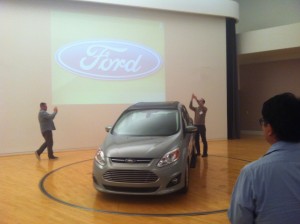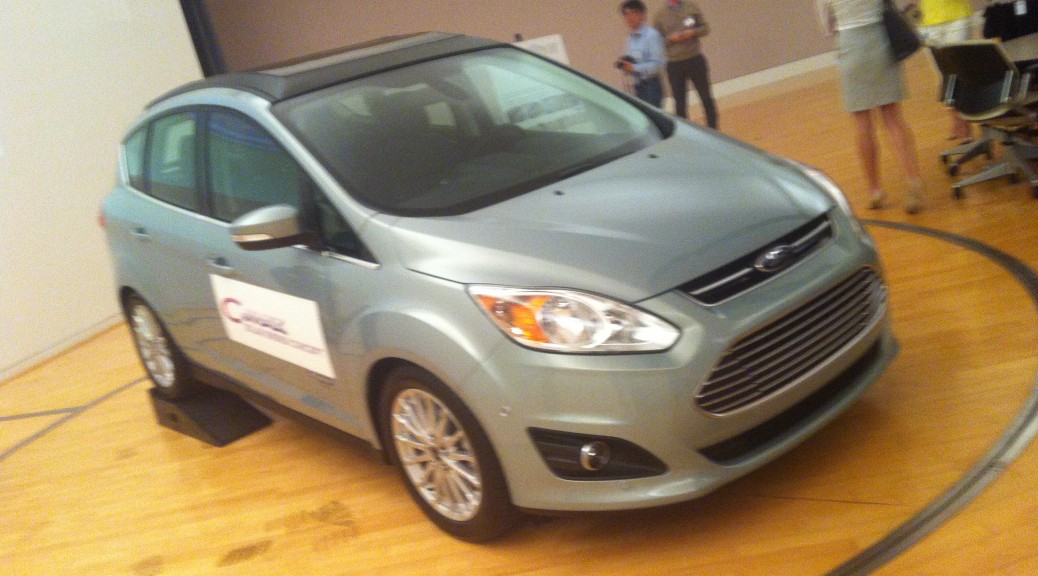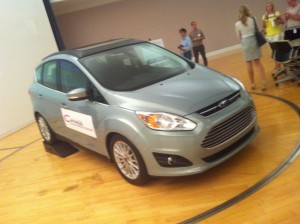Ford allowed its C-Max Solar Energi concept to be placed under the magnifying glass, literally.
On May 29, 2014, the Blue Oval manufacturer held a media luncheon and Q&A session at their Irvine Showroom to showcase the Ford C-Max Solar Energi concept vehicle and discuss the “future of electrification.”
First, let me point out that Ford is very upfront about this being a concept in the strongest definition of the word. This is no pre-production mockup to tease what may be showing up on next year’s auto show circuit, merely a design exercise to see what could be done to push today’s technology into tomorrow, albeit a somewhat distant tomorrow. That’s not to say that the C-Max Solar Energi concept isn’t a functional vehicle. It is still a fully functional Ford C-Max Energi plug-in hybrid. It just as the extra benefit of having a solar panel array on its roof to aid in charging.
Not terribly exciting technology. Solar panels are nothing new, and we know that in limited arrays they are great for low voltage applications, and given enough acreage, have been successfully used by utility companies to fortify the grid. The problem is, there isn’t that much acreage available on the body of a car, so solar panels alone don’t offer much in the way of a charge for an electric vehicle—about 3 miles worth of driving in the C-Max Solar Energi depending on how much sunshine is available in your area on a clear day. Not a practical solution for the average commuter and Ford knows it. The real design study behind the C-Max Solar Energi concept and the problem Ford is trying to solve is how to improve the efficiency of harnessing that sunshine into a useful amount of energy. Here’s where the Solar Energi concept literally gets put under the magnifying glass.
 Ever used a magnifying glass to burn ants when you were a kid? That same intense dose of supercharged sunshine that sent those little six-legged picnic bandits to the great anthill in the sky is being used to improve the intensity of the sun hitting those solar panels adorning the C-Max roofline. To achieve this, engineers have designed a carport type structure with a roof that is basically a large magnifying glass, Ford calls it the “concentrator.” The same concept is used in solar farms where parabolic mirrors reflect the sun’s rays from every point on the surface of the mirror into a collector at the focal point. These mirrors, however, track the position of the sun and adjust accordingly to maximize the available sunlight. A similar system for a home carport would be cost prohibitive so how do you make sure you are getting the maximum benefit of the sun without repositioning the magnifying glass? Move the car.
Ever used a magnifying glass to burn ants when you were a kid? That same intense dose of supercharged sunshine that sent those little six-legged picnic bandits to the great anthill in the sky is being used to improve the intensity of the sun hitting those solar panels adorning the C-Max roofline. To achieve this, engineers have designed a carport type structure with a roof that is basically a large magnifying glass, Ford calls it the “concentrator.” The same concept is used in solar farms where parabolic mirrors reflect the sun’s rays from every point on the surface of the mirror into a collector at the focal point. These mirrors, however, track the position of the sun and adjust accordingly to maximize the available sunlight. A similar system for a home carport would be cost prohibitive so how do you make sure you are getting the maximum benefit of the sun without repositioning the magnifying glass? Move the car.
Why install additional electric motors into a carport roof when there is already an electric motor installed in your car? This is exactly what Ford did to adjust for the position of the sun as it made its way across the sky. Configuring the concentrator in an east-west direction, the C-Max Solar Energi starts out on the west side of the car port to catch the sun’s rays as they angle in from the east. As the sun rises, the C-Max Solar Energi literally inches its way westward an inch at a time until it arrives on the east side of the concentrator as the sun sinks in the west. Clever.
Of course, there are still other variables in this scenario. The sun doesn’t follow the same path across the sky, varying its path across the sky toward the north during summer in the northern hemisphere and winding south during the winter, so the concentrator would need to correct its angle for this as well. And what about a vehicle that automatically repositions itself? Sure it only moves an inch at a time, but it’s a silent inch. I can’t tell you how many of the neighbor’s cats nine lives have been spent narrowly escaping from underneath a tire where it was enjoying the shade and a little respite from the summer sun. Without the warning of an exhaust note, there’s no cue for Mr. Whiskers to scamper. I imagine it would be pretty horrible if he was partially pinned as the vehicle inched over his paw or tail and with no one around to hear his cries, had the life squeezed out of the remaining parts of his body one inch at a time. Ew. And I don’t even like cats.
Those problems aside, what is intriguing about all of this is imagining being able to own and drive a vehicle off the grid. No fueling up, no plugging in, just free energy from the sun. Now take this same technology and meld it with a car an enthusiast could appreciate, something along the lines of the electric Tesla Roadster, or the hybrid Porsche 917 Spyder. Or how about adding it to a luxury car like the Cadillac ELR or a Lexus hybrid SUV. For day to day commutes, vehicles could be emission free, only relying on fuel for longer road trips or rainy days. I’m excited, and hope others will see what Ford has accomplished and pitch in to take this technology to the next level. Cars would no longer be the poster child of eco irresponsibility, and there would once again be room for those who prefer performance and luxury over gadgets and fuel economy, and that’s a world I’d gladly welcome… with or without Mr. Whiskers.



